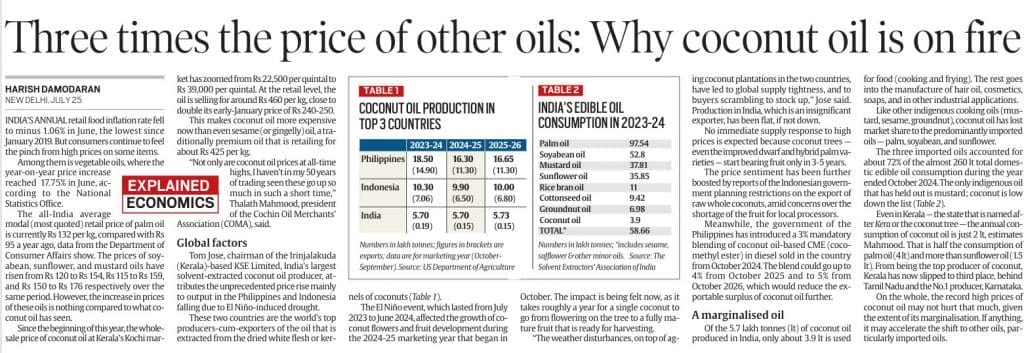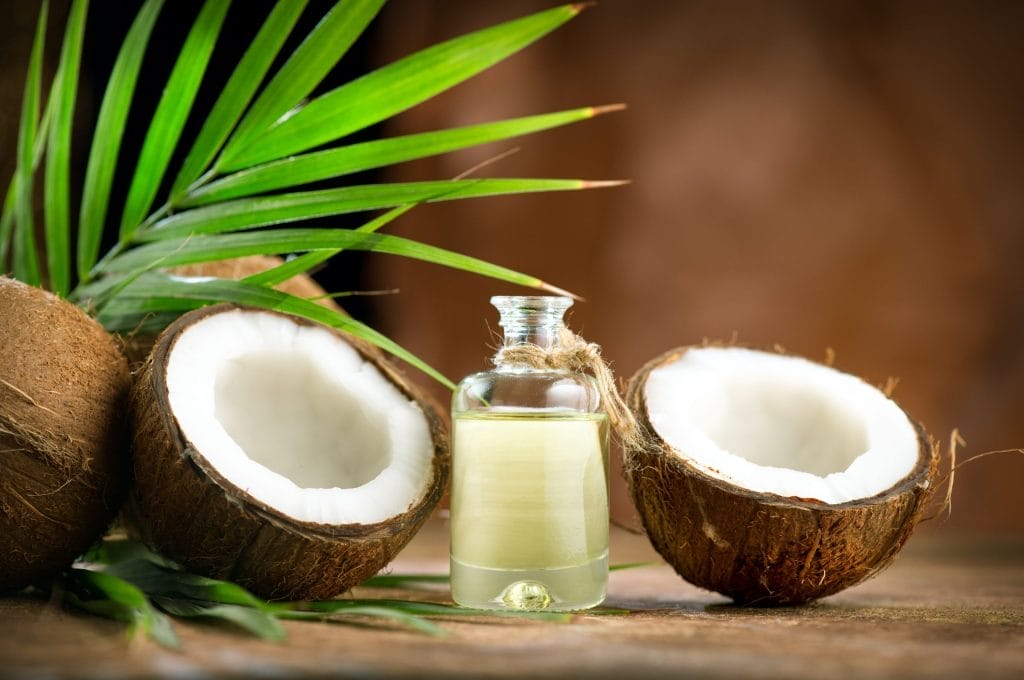
Why in News:
Amidst rise in edible oil prices, Coconut Oil prices has risen to become almost three times the price of other oils making it even more expensive than traditionally premium Sesame oil.
UPSC CSE Relevance:
UPSC CSE in prelims examination has focused on different boards like Tea Board, Coffee Board and Turmeric Board etc. A case in point is a following PYQ.
UPSC Prelims PYQ 2022
Consider the following States:
- Andhra Pradesh
- Kerala
- Himachal Pradesh
- Tripura
How many of the above are generally known as tea-producing States?
(a) Only one State
(b) Only two States
(c) Only three States
(d) All four States
Coconut Oil
- Extracted from dried white flesh of coconut called Copra.
- Copra is an MSP crop
- Of the 5.7 lakh tonnes (It) of coconut oil produced in India, only about 3.9 It is used for food (cooking and frying). The rest goes into the manufacture of hair oil, cosmetics, soaps, and in other industrial applications as a natural solvent.

Largest producers in India:
- Karnataka
- Tamil Nadu
- Kerala
Largest global producer:
- Philippines
- Indonesia
- India
Cause of recent rise in prices of Coconut Oil:
- In addition to this, the aging coconut plantations in the two countries, have led to global supply tightness, and to buyers scrambling to stock up.
- Experts attribute the unprecedented price rise mainly to output in the Philippines and Indonesia falling due to El Niño-induced drought. These two countries are the world’s top producers-cum-exporters of coconut oil.
Impact on India
- Since there is marginal consumption of oil in India, it may accelerate shift to other oils, primarily the imported oils.
- There are three primarily imported edible oils in India that dominate consumption- palm, soybean and sunflower in decreasing order of consumption.
- These 3 imported oils account for 74% edible oil consumption in India.
- The only indigenous oil that has held out is Mustard Oil. It is the most consumed indigenous oil and largest after the three imported oils.
Coconut Growing Conditions:
- Latitude and Altitude: Coconut is a tropical crop and grows well a hot climate.
- Temperature: The temperature should be from 20 ° to 32°C.
- Rainfall: A total of 1000 mm is sufficient, if it is evenly distributed throughout the year. However, rainfall upto 3000 mm is also ideal for coconut cultivation.
- Humidity and Wind: The optimum relative humidity is 80 – 85 percent.
- Sunshine: The palm requires plenty of sunlight and does not grow well under shade or in cloudy conditions.
- Soil types: Laterite, coastal sandy, alluvial, and also in reclaimed soils of the marshy lowlands. It tolerates salinity and a wide range of pH (from 5.0-8.0).
About Coconut Board:
- Coconut Development Board (CDB) is a statutory body established under the Ministry of Agriculture and Farmers Welfare, Government of India for the integrated development of coconut cultivation and industry in the country with focus on productivity increase and product diversification.
- The Board which came into existence on 12th January 1981.
- Its Headquarters at Kochi in Kerala and Regional Offices at Bangalore in Karnataka, Chennai in Tamil Nadu, Guwahati in Assam and Patna in Bihar.
- Aim: Adopting measures for the development of coconut industry.

